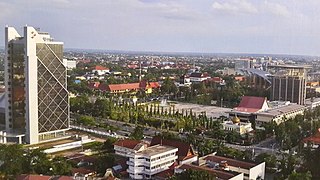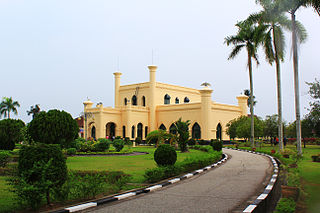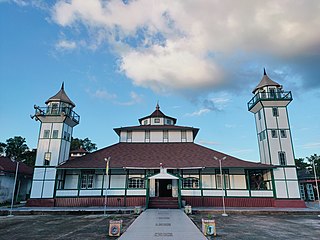
Riau is a province of Indonesia. It is located on the central eastern coast of the island of Sumatra, and extends from the eastern slopes of the Barisan Mountains to the Malacca Strait, including several large islands situated within the Strait. The province shares land borders with North Sumatra to the northwest, West Sumatra to the west, and Jambi to the south, and a maritime border with the Riau Islands and the country of Malaysia to the east. It is the second-largest province in the island of Sumatra after South Sumatra, and is slightly larger than the nation of Jordan. According to the 2020 census, Riau had a population of 6,394,087 across a land area of 89,935.90 km²; the official estimate of population as of mid-2023 was 6,642,874. The province comprises ten regencies and two cities, with Pekanbaru serving as the capital and largest city.

Pekanbaru is the capital city of the Indonesian province Riau, and a major economic center on the eastern side of Sumatra Island with its name derived from the Malay words for 'new market' . It has an area of 632.26 km2 (244.12 sq mi), with a population of 897,767 at the 2010 Census, and 983,356 at the 2020 Census; the official estimate as at mid 2023 was 1,123,348. It is located on the banks of the Siak River, which flows into the Strait of Malacca, Pekanbaru has direct access to the busy strait and has long been known as a trading port.

Istiqlal Mosque in Jakarta, Indonesia is the largest mosque in Southeast Asia and the ninth largest mosque in the world in terms of worshipper capacity. Built to commemorate Indonesian independence, this national mosque of Indonesia was named "Istiqlal", an Arabic word for "independence". The mosque was opened to the public on 22 February 1978. Within Jakarta, the mosque is positioned next to Merdeka Square, the Jakarta Cathedral (Catholic), and also of the Immanuel Church (Reformed).

Mughal architecture is the type of Indo-Islamic architecture developed by the Mughals in the 16th, 17th and 18th centuries throughout the ever-changing extent of their empire in the Indian subcontinent. It developed from the architectural styles of earlier Muslim dynasties in India and from Iranian and Central Asian architectural traditions, particularly Timurid architecture. It also further incorporated and syncretized influences from wider Indian architecture, especially during the reign of Akbar. Mughal buildings have a uniform pattern of structure and character, including large bulbous domes, slender minarets at the corners, massive halls, large vaulted gateways, and delicate ornamentation; examples of the style can be found in modern-day Afghanistan, Bangladesh, India and Pakistan.

Sultan Syarif Kasim II International Airport, is an international airport serving the city of Pekanbaru, Riau, Indonesia. The airport is often referred to as SSK II, SSK or Sultan Syarif Qasim II International Airport, and was formerly known as Simpang Tiga Airport. The airport is named after Sultan Syarif Kasim II (1893–1968), the last sultan of Siak and an Indonesian National Hero. The airport serves flights to and from several cities and towns in Indonesia as well as international connections to Malaysia, Saudi Arabia, Singapore, Sri Lanka, and Thailand.

Siak, is a regency (kabupaten) of Riau Province, on the island of Sumatra, Indonesia. It has an area of 8,556.09 km2 and had a population of 376,742 at the 2010 Census and 457,940 at the 2020 Census; the official estimate as at mid 2023 was 480,169, comprising 246,489 males and 233,680 females. The administrative centre of the regency is located at Siak Sri Indrapura in Mempura District. The northern part of this regency contains a large part of the Bukit Batu Biosphere Reserve.

The Taj-ul-Masajid or Tāj-ul-Masjid, is a mosque situated in Bhopal, Madhya Pradesh, India. It is the largest mosque in India and one of the largest mosques in the world.
Hang Tuah Stadium was formerly a multi-use stadium in Pekanbaru, Riau, Indonesia. It was normally used for football matches and as the home venue for PSPS Pekanbaru of the Liga Indonesia. The stadium had a capacity of 5,000 spectators.

The Sultanate of Siak Sri Indrapura, often called Sultanate of Siak, was a kingdom that was located in present-day Siak Regency, and nearby other regions from 1722 to 1949. It was founded by Raja Kecil, who had close relations with the Johor Sultanate, after he failed to seize the Johor throne. The polity expanded in the 18th century to encompass much of eastern Sumatra as it brought various communities under its control through warfare and control of trade between the interior of Sumatra and the Malacca Strait. The Dutch colonial state signed a series of treaties with the Siak rulers in the 19th century, which reduced the area of state influence to the Siak River. For the remainder of the Dutch colonial era, it operated as an independent state with Dutch advisors. After Indonesia's Independence was proclaimed on 17 August 1945, the last sultan of Siak, Sultan Syarif Kasim II, declared his kingdom to join the Republic of Indonesia.

Persian Inscriptions on Indian Monuments is a book written in Persian by Dr Ali Asghar Hekmat E Shirazi and published in 1956 and 1958 and 2013. New edition contains the Persian texts of more than 200 epigraphical inscriptions found on historical monuments in India, many of which are currently listed as national heritage sites or registered as UNESCO world heritage, published in Persian; an English edition is also being printed.
Sultan Syarif Kasim State Islamic University in Riau is a public university in Pekanbaru, Riau, Indonesia. It was established on January 4, 2005. Before 2005, its name was IAIN Sultan Syarif Kasim Riau and changed by Religion Ministry of Indonesia's Decree No.8 of 2005. Its current rector is Prof. Dr. H. Munzir Hitami, M.A.

The Great Mosque of Palembang, also known as Sultan Mahmud Badaruddin I Great Mosque after the former Sultan of Palembang, is the main mosque of Palembang, the capital of South Sumatra. The mosque is the largest in South Sumatra, and the third largest mosque in Sumatra after the Grand Mosque of West Sumatra and Great Mosque of Pekanbaru.
Dian Al-Mahri Mosque, also known as Golden Dome Mosque(Masjid Kubah Emas), is a mosque built on the edge of Raya street, Depok City in West Java, Indonesia. In addition to being a place of daily worship for Muslims, this mosque area attracts many locals and tourists because its domes are made of gold. Because of the vastness of the area and its accessibility to the public, this place is often a holiday destination for family or a place to take a rest.

Jami Mosque of Sintang also known as Sultan Nata Mosque is a mosque located in Sintang, West Kalimantan, Indonesia. The mosque is located within the complex of Istana al-Mukarrammah, the main palace of the Sultanate of Sintang, a kingdom in Sintang which existed since the 13th-century.

Mosque architecture in Indonesia refers to the architectural traditions of mosques built in the archipelago of Indonesia. Initial forms of the mosque, for example, were predominantly built in the vernacular Indonesian architectural style mixed with Hindu, Buddhist or Chinese architectural elements, and notably didn't equip orthodox form of Islamic architectural elements such as dome and minaret. Vernacular architectural style varies depending on the island and region.

Jami Mosque of Pontianak, also known as Sultan Syarif Abdurrahman Mosque, is the oldest mosque of Pontianak, in Kalimantan, Indonesia. The large wooden mosque, together with the royal palace of Kraton Kadriyah, was among the first buildings constructed in the city following the establishment of Pontianak in 1771.

Siak Sri Indrapura Palace or Siak Palace is an istana of the Sultanate of Siak Sri Indrapura that is located at Siak Regency, Riau, on the island of Sumatra, Indonesia. The palace is now transformed into a museum.
Tengku Agung Syarifah Latifah was a queen consort of Syarif Kasim II and a prominent figure from Riau who advocated for women's emancipation and education. She was known as the founder of the first women's school in Riau.
Tengku Maharatu Syarifah Fadlun, known as Tengku Maharatu, was the second queen consort of Sultan Syarif Kasim II and education figure from Riau.
























